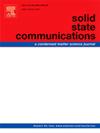Bi, Cr and Ag dopants in PbTe and SnTe: Impact of the host band symmetry on doping properties by ab initio calculations
IF 2.4
4区 物理与天体物理
Q3 PHYSICS, CONDENSED MATTER
引用次数: 0
Abstract
Doping properties of Bi, Cr and Ag dopants in thermoelectric and topological materials PbTe and SnTe are analyzed based on density functional theory calculations in the local density approximations and the large supercell method. In agreement with experiment, in both PbTe and SnTe, Bi is a donor and Ag is an acceptor with a vanishing magnetic moment. In contrast, Cr is a resonant donor in PbTe, and an resonant acceptor in SnTe. We also consider the electronic structure of cation vacancies in PbTe and SnTe, since these abundant native defects induce -type conductivity in both hosts. The quantitatively different impact of these dopants/defects on the host band structure of PbTe and SnTe (level energies, band splittings, band inversion, and a different level of hybridization between dopant and host states) is explained based on the group-theoretical arguments.
PbTe和SnTe中Bi、Cr和Ag掺杂物:主能带对称性对掺杂性质的影响
基于局部密度近似的密度泛函理论计算和大超级单体方法,分析了Bi、Cr和Ag掺杂剂在热电和拓扑材料PbTe和SnTe中的掺杂性质。与实验结果一致,在PbTe和SnTe中,Bi为供体,Ag为受体,磁矩消失。相反,Cr在PbTe中是一个共振供体,在SnTe中是一个共振受体。我们还考虑了PbTe和SnTe中阳离子空位的电子结构,因为这些丰富的天然缺陷在两者中都诱导了p型电导率。这些掺杂剂/缺陷对PbTe和SnTe的主能带结构(能级能、能带分裂、能带反转以及掺杂剂与主能带之间不同程度的杂化)的定量不同影响基于群论的论点得到了解释。
本文章由计算机程序翻译,如有差异,请以英文原文为准。
求助全文
约1分钟内获得全文
求助全文
来源期刊

Solid State Communications
物理-物理:凝聚态物理
CiteScore
3.40
自引率
4.80%
发文量
287
审稿时长
51 days
期刊介绍:
Solid State Communications is an international medium for the publication of short communications and original research articles on significant developments in condensed matter science, giving scientists immediate access to important, recently completed work. The journal publishes original experimental and theoretical research on the physical and chemical properties of solids and other condensed systems and also on their preparation. The submission of manuscripts reporting research on the basic physics of materials science and devices, as well as of state-of-the-art microstructures and nanostructures, is encouraged.
A coherent quantitative treatment emphasizing new physics is expected rather than a simple accumulation of experimental data. Consistent with these aims, the short communications should be kept concise and short, usually not longer than six printed pages. The number of figures and tables should also be kept to a minimum. Solid State Communications now also welcomes original research articles without length restrictions.
The Fast-Track section of Solid State Communications is the venue for very rapid publication of short communications on significant developments in condensed matter science. The goal is to offer the broad condensed matter community quick and immediate access to publish recently completed papers in research areas that are rapidly evolving and in which there are developments with great potential impact.
 求助内容:
求助内容: 应助结果提醒方式:
应助结果提醒方式:


